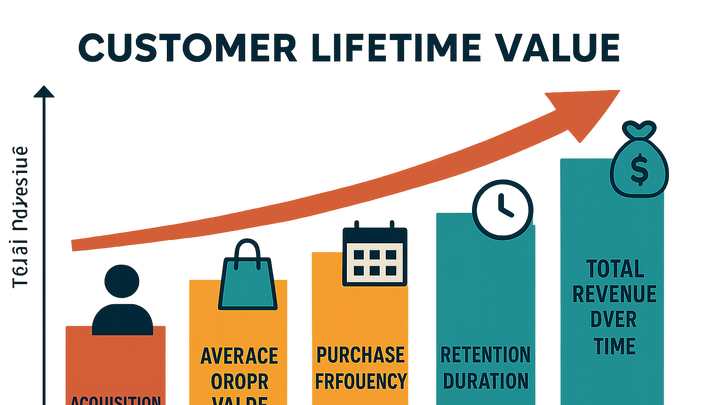Published on 2025-06-28T06:01:41Z
What is Customer Lifetime Value (CLTV)? Examples and Calculation in Analytics
Customer Lifetime Value (CLTV) is a predictive metric that estimates the total revenue a business can expect from a single customer over the course of their relationship. In analytics, CLTV is crucial for understanding customer profitability, guiding marketing spend, and shaping customer retention strategies. By comparing CLTV against acquisition costs, companies can ensure sustainable growth and optimize budget allocation. CLTV can be calculated using straightforward historical data or through advanced predictive models that leverage machine learning. Leading analytics tools such as PlainSignal and Google Analytics 4 (GA4) provide built-in capabilities to measure and forecast CLTV, enabling data-driven decisions. Effectively tracking and improving CLTV can lead to stronger customer relationships and increased long-term revenue.
Customer lifetime value (cltv)
CLTV measures the total revenue a customer generates throughout their relationship, guiding growth and retention strategies.
Why Customer Lifetime Value Matters
Understanding CLTV is essential for making strategic decisions in marketing, sales, and customer success. It helps businesses allocate budgets wisely, forecast long-term revenue, and identify high-value customer segments for targeted campaigns.
-
Revenue growth forecasting
CLTV provides insights into the expected profit per customer over time, enabling accurate revenue projections.
-
Marketing budget allocation
By comparing CLTV to acquisition costs, companies can optimize ad spend to ensure a positive return on investment.
-
Customer segmentation
Segmenting customers based on CLTV helps tailor retention efforts toward the most valuable groups.
How to Calculate CLTV
CLTV calculation methods range from simple formulas based on historical purchase data to sophisticated predictive models using customer behavior analytics.
-
Traditional formula
A basic calculation multiplies the average order value by purchase frequency and average customer lifespan.
-
Average order value
Total revenue divided by the number of orders in a period.
-
Purchase frequency
Average number of purchases per customer over a given timeframe.
-
Customer lifespan
Average duration a customer continues to make purchases.
-
-
Cohort analysis
Analyzing groups of customers acquired simultaneously to track retention rates and revenue per cohort over time.
-
Retention curve
Percentage of customers remaining active at each time interval.
-
Revenue per cohort
Revenue generated by each cohort across different periods.
-
-
Predictive models
Machine learning techniques forecast CLTV by analyzing past behaviors, demographics, and interaction patterns.
-
Regression techniques
Estimate the relationship between customer attributes and future spending.
-
Survival analysis
Model the likelihood of customer churn over time to predict customer lifespan.
-
Measuring CLTV with PlainSignal and GA4
Implementing CLTV tracking in both cookie-free and traditional analytics platforms ensures comprehensive insights. PlainSignal offers a privacy-focused approach, while GA4 provides advanced predictive metrics.
-
Implementing PlainSignal tracking
Use PlainSignal’s lightweight script to capture user behaviors and revenue events essential for CLTV computation.
-
Preconnect setup
Add this link tag to improve performance and establish early connections:
<link rel="preconnect" href="//eu.plainsignal.com/" crossorigin /> -
Script integration
Insert the PlainSignal script with required data attributes:
<script defer data-do="yourwebsitedomain.com" data-id="0GQV1xmtzQQ" data-api="//eu.plainsignal.com" src="//cdn.plainsignal.com/plainsignal-min.js"></script> -
Event tracking
Configure purchase and revenue events in PlainSignal’s dashboard to automatically feed into CLTV metrics.
-
-
Setting up cltv in GA4
GA4’s flexible event-driven model and predictive capabilities allow for detailed CLTV tracking and forecasting.
-
Enable enhanced ecommerce
Activate Enhanced Ecommerce features and configure purchase events within GA4.
-
Create custom metric
Define a custom metric to aggregate total revenue per user for lifetime calculations.
-
Use predictive metrics
Leverage GA4’s predictive revenue metrics to estimate future customer value.
-
Best Practices to Improve CLTV
Enhance CLTV by focusing on retention, personalization, and revenue optimization strategies that foster long-term customer relationships.
-
Enhancing customer retention
Implement loyalty programs, subscription models, and proactive customer support to reduce churn and increase repeat purchases.
-
Personalization strategies
Use segmentation data to deliver tailored content and offers, boosting engagement and purchase frequency.
-
Upselling and cross-selling
Recommend relevant products and upgrades to existing customers to increase average order value and overall CLTV.
